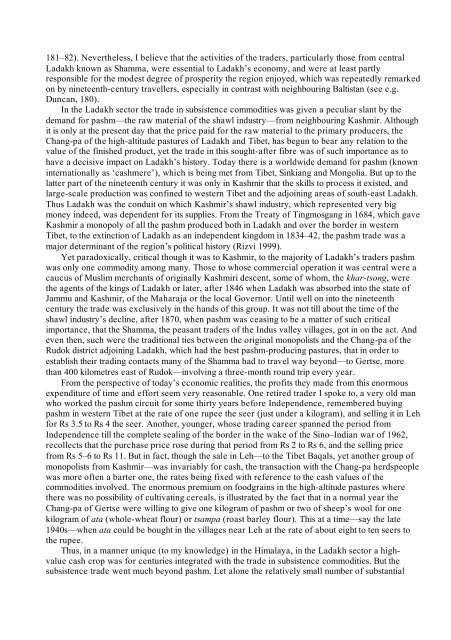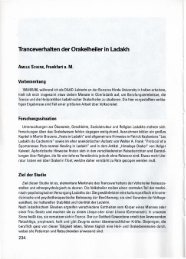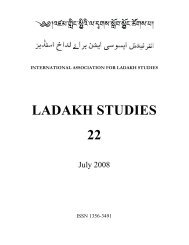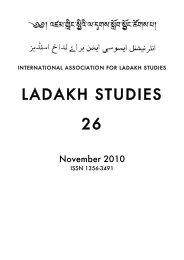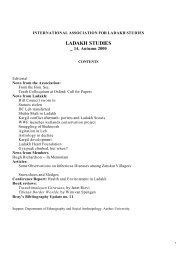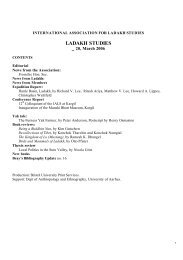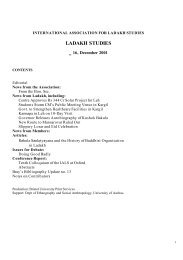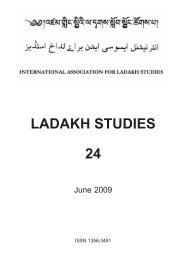LADAKH STUDIES 12, Autumn 1999 - International Association for ...
LADAKH STUDIES 12, Autumn 1999 - International Association for ...
LADAKH STUDIES 12, Autumn 1999 - International Association for ...
You also want an ePaper? Increase the reach of your titles
YUMPU automatically turns print PDFs into web optimized ePapers that Google loves.
181–82). Nevertheless, I believe that the activities of the traders, particularly those from central<br />
Ladakh known as Shamma, were essential to Ladakh’s economy, and were at least partly<br />
responsible <strong>for</strong> the modest degree of prosperity the region enjoyed, which was repeatedly remarked<br />
on by nineteenth-century travellers, especially in contrast with neighbouring Baltistan (see e.g.<br />
Duncan, 180).<br />
In the Ladakh sector the trade in subsistence commodities was given a peculiar slant by the<br />
demand <strong>for</strong> pashm—the raw material of the shawl industry—from neighbouring Kashmir. Although<br />
it is only at the present day that the price paid <strong>for</strong> the raw material to the primary producers, the<br />
Chang-pa of the high-altitude pastures of Ladakh and Tibet, has begun to bear any relation to the<br />
value of the finished product, yet the trade in this sought-after fibre was of such importance as to<br />
have a decisive impact on Ladakh’s history. Today there is a worldwide demand <strong>for</strong> pashm (known<br />
internationally as ‘cashmere’), which is being met from Tibet, Sinkiang and Mongolia. But up to the<br />
latter part of the nineteenth century it was only in Kashmir that the skills to process it existed, and<br />
large-scale production was confined to western Tibet and the adjoining areas of south-east Ladakh.<br />
Thus Ladakh was the conduit on which Kashmir’s shawl industry, which represented very big<br />
money indeed, was dependent <strong>for</strong> its supplies. From the Treaty of Tingmosgang in 1684, which gave<br />
Kashmir a monopoly of all the pashm produced both in Ladakh and over the border in western<br />
Tibet, to the extinction of Ladakh as an independent kingdom in 1834–42, the pashm trade was a<br />
major determinant of the region’s political history (Rizvi <strong>1999</strong>).<br />
Yet paradoxically, critical though it was to Kashmir, to the majority of Ladakh’s traders pashm<br />
was only one commodity among many. Those to whose commercial operation it was central were a<br />
caucus of Muslim merchants of originally Kashmiri descent, some of whom, the khar-tsong, were<br />
the agents of the kings of Ladakh or later, after 1846 when Ladakh was absorbed into the state of<br />
Jammu and Kashmir, of the Maharaja or the local Governor. Until well on into the nineteenth<br />
century the trade was exclusively in the hands of this group. It was not till about the time of the<br />
shawl industry’s decline, after 1870, when pashm was ceasing to be a matter of such critical<br />
importance, that the Shamma, the peasant traders of the Indus valley villages, got in on the act. And<br />
even then, such were the traditional ties between the original monopolists and the Chang-pa of the<br />
Rudok district adjoining Ladakh, which had the best pashm-producing pastures, that in order to<br />
establish their trading contacts many of the Shamma had to travel way beyond—to Gertse, more<br />
than 400 kilometres east of Rudok—involving a three-month round trip every year.<br />
From the perspective of today’s economic realities, the profits they made from this enormous<br />
expenditure of time and ef<strong>for</strong>t seem very reasonable. One retired trader I spoke to, a very old man<br />
who worked the pashm circuit <strong>for</strong> some thirty years be<strong>for</strong>e Independence, remembered buying<br />
pashm in western Tibet at the rate of one rupee the seer (just under a kilogram), and selling it in Leh<br />
<strong>for</strong> Rs 3.5 to Rs 4 the seer. Another, younger, whose trading career spanned the period from<br />
Independence till the complete sealing of the border in the wake of the Sino–Indian war of 1962,<br />
recollects that the purchase price rose during that period from Rs 2 to Rs 6, and the selling price<br />
from Rs 5–6 to Rs 11. But in fact, though the sale in Leh—to the Tibet Baqals, yet another group of<br />
monopolists from Kashmir—was invariably <strong>for</strong> cash, the transaction with the Chang-pa herdspeople<br />
was more often a barter one, the rates being fixed with reference to the cash values of the<br />
commodities involved. The enormous premium on foodgrains in the high-altitude pastures where<br />
there was no possibility of cultivating cereals, is illustrated by the fact that in a normal year the<br />
Chang-pa of Gertse were willing to give one kilogram of pashm or two of sheep’s wool <strong>for</strong> one<br />
kilogram of ata (whole-wheat flour) or tsampa (roast barley flour). This at a time—say the late<br />
1940s—when ata could be bought in the villages near Leh at the rate of about eight to ten seers to<br />
the rupee.<br />
Thus, in a manner unique (to my knowledge) in the Himalaya, in the Ladakh sector a highvalue<br />
cash crop was <strong>for</strong> centuries integrated with the trade in subsistence commodities. But the<br />
subsistence trade went much beyond pashm. Let alone the relatively small number of substantial<br />
32


